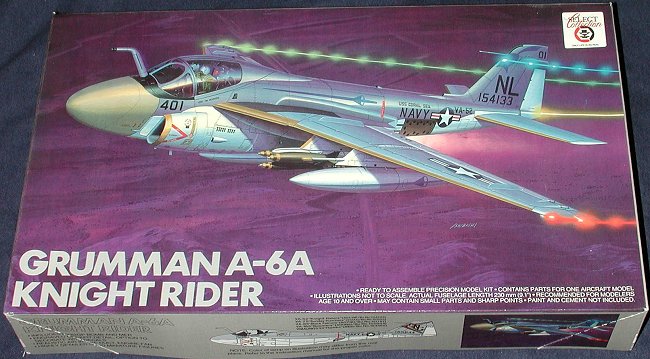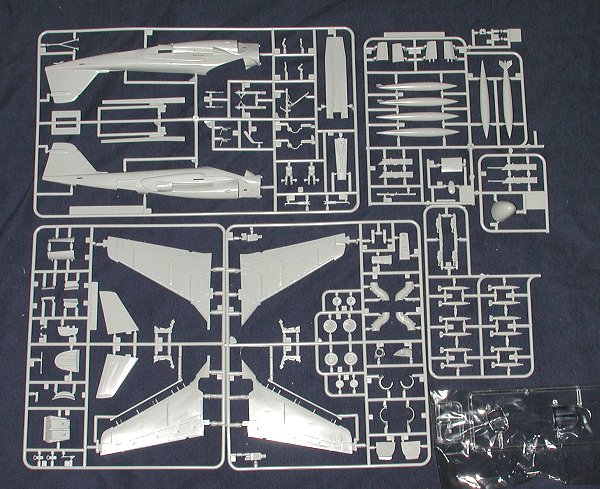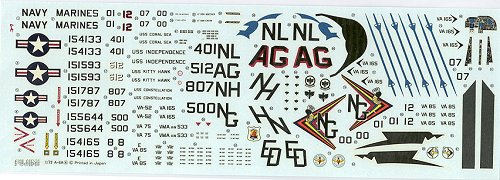
| KIT: | Fujimi 1/72 A-6A Intruder |
| KIT # | 27016 (H-16) |
| PRICE: | @$20 |
| DECALS: | Five (!) Aircraft |
| REVIEW & | |
| NOTES: | ` |

| HISTORY |
Initially designated A2F, the Intruder first flew in mid 1960and was just what the Navy needed. The aircraft was requested for use by theMarines in the close air support role and to take over the long rangeinterdiction role for the Navy. Both of these roles were being performed by theAD Skyraider and a fast jet replacement was needed. Though the final design isnothing that one could call sleek and sexy, the purposeful Intruder was able tomeet all the goals set for it. A first for BuAir was that the airframemanufacturer was responsible for all aspect of the plane from engines toavionics. In the past the Navy has required the airframe manufacturer to usespecified equipment, but that had produced a number of fiascos such as the F3HDemon and others who were saddled with unsatisfactory engines.
Naturally, there were some problems in development, but thosewere ironed out and the first production A-6s (as they were called from 1962onward). In late 1962, the first production aircraft were delivered to VA-42 theEast Coast fleet replacement squadron (FRS). It was quickly integrated into thefleet and by the time the Vietnam war had heated up, there were a number of A-6Asquadrons aboard carriers and carrying out strike missions against targets inboth North and South Vietnam.
Over the years, several different versions of the plane weredeveloped, but only the A-6E with its improved sensor suite was ever put intoproduction. Many A6Es were actually rebuilt A-6A airframes and they did notalways incorporate the full sensors until the program was well underway. Thereare two ways to tell an A-6E from an A-6A. One is from the FLIR pod that jutsbelow the nose radome. The other is from the rear airbrakes. On new build A-6Esthese are either solid or not there at all. A-6As had perforated airbrakes. Emodels also have a large cooling scoop just forward of the fin. Other A-6As weredeveloped into dedicated tankers and called KA-6Ds.
In the 1980s, a vastly improved A-6F was developed. This had allthe latest bells and whistles as well as improved turbofan engines. It wouldhave been the next generation of Intruder. However it was not built, though someof its systems were used in the last batch of 12 A-6Es to be built. Theseaircraft dribbled off the production line over several years and were verycostly to produce. It was finally decided the the A-6 was too expensive tomaintain and Intruder units either went away or transitioned to the much lesscapable F-18 Hornet. As a result, many A-6s, some with very few airframe hourson them, were either cut up, dumped into the Gulf of Mexico or used as targetson various ranges. With the demise of the Intruder, so went the tanker fleet.There are times when those of us who are military aircraft enthusiasts wonderwhat in the world the people who make these decisions are thinking. Now the Navyhas no truly capable long range interdiction aircraft and no dedicatedcarrier-based tankers. Fortunately, the F-18Ds that are operated by the Marinesare relatively capable, but still do not have the range/payload of the olderA-6s.
| THE KIT |

The Fujimi 1/72 A-6A kit is really a superb looking kit. Yet Ihave never seen one built. Why not is a real mystery to me. The kit haseverything one could want from a model of the late 80s; finely engraved panellines, a full cockpit with raised detail on the instrument panel and sideconsoles (or you can put decals over them), crystal clear canopy that can bedisplayed open or closed, complete intake and exhaust trunking with enginecompressor faces, a full weapons load, separate leading edge slats, and a superbdecal sheet with five colorful examples. This kit is just as nice as their A-7series.
I can only guess that since it isn't as sexy as otherplanes that it isn't as popular. And it is a shame as this one looks to be agreat model. OK, it isn't perfect. I did find some ejector pin marks in placesthat could be difficult to remove them. They were found on a few gear doorinteriors, the inside of the exhaust trunks, and on the nose gear strut. It willalso be difficult to get a smooth finish on the exhaust trunking as it isconvoluted and will be tough to sand, but you can paint it black and no one willknow.
In addition to the goodies I mentioned above, thereare two sets of fuselage speed brakes and things under wings includes three droptanks (one for the fuselage centerline), and two MERS with a full load of Mk 80series slick bombs. The kit supplied MERS and bombs are a nice as what you'dfind on the Hasegawa weapons set.
 Instructions are very good and comparable to those from Hasegawa.Paints are referenced to Gunze and given generic names. No FS numbers are given,but we all know that these birds were painted light gull grey over white so thatreally isn't an issue for most of us. What is really a killer is the decalsheet. As you can see from the image, you get a lot of markings. There areaircraft from VA-52, VA-75, VA-85, VA-165 and VMA-533. All of them in thecolorful markings of the late 60's and early 1970s before low viz took over. Allof them are Vietnam veterans. You also get the walkways and other commonmarkings. I would replace the national insignia as they just don't look right,the 'wings' look too long.
Instructions are very good and comparable to those from Hasegawa.Paints are referenced to Gunze and given generic names. No FS numbers are given,but we all know that these birds were painted light gull grey over white so thatreally isn't an issue for most of us. What is really a killer is the decalsheet. As you can see from the image, you get a lot of markings. There areaircraft from VA-52, VA-75, VA-85, VA-165 and VMA-533. All of them in thecolorful markings of the late 60's and early 1970s before low viz took over. Allof them are Vietnam veterans. You also get the walkways and other commonmarkings. I would replace the national insignia as they just don't look right,the 'wings' look too long.
As I hope I have conveyed, this isreally a cool kit and one that deserves to be built more than it is. If you'vebuilt this model (which I haven't), I'd appreciate any insights.
| REFERENCES |
Grumman Aircraft since 1929 by Rene J Francillon
Review kit courtesy of me and my wallet!
If you would like your product reviewed fairly and fairly quickly by asite that averages over 3,000 visits a day, please contactme or see other details in the